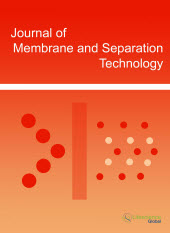JMST
Special Issues | Journal of Membrane and Separation Technology
Membranes for Carbon Dioxide Separation/Capture applications
|
The following Special Issue(s) will be published in this journal. If you are interested to contribute to any of the listed Special Issue(s) below, please click on the email address given below. |
||||
| S. No | Guest Editors | Topic | Submit Manuscripts |
Description |
| 1 | Evangelos P. Favvas | Membranes for Carbon Dioxide Separation/Capture applications |
This email address is being protected from spambots. You need JavaScript enabled to view it. |
Published |
Journal of Membrane and Separation Technology | Volume 4 Number 1
|
|
Synthesis and Characterization of Nanocomposite Hydroxy-Sodalite/Ceramic Membrane via Pore-Plugging Hydrothermal Synthesis Technique - Pages 1-7 A Novel Approach to Synthesize Helix Wave Hollow Fiber Membranes for Separation Applications - Pages 8-14 Control of Membrane Surface Roughness and Pattern Wave Length by Changing the Nonsolvent (Water) Influx Rate - Pages 15-24 Scrutinizing the Nanostructural and Nanomechanical Features of Regenerated Cellulose Ultrafiltration Membranes - Pages 25-31 |
Acknowledgement | Journal of Membrane and Separation Technology
"Lifescience Global received 5 manuscripts during the period of 2020 for Journal of Membrane and Separation Technology. All manuscript rejected by the EiC."
Lifescience Global would like to appreciate and thank all the reviewers and authors for their rigorous and conscientious efforts for the Journal of Membrane and Separation Technology. Below is the list of people who contributed towards the success of the journal during 2019.
|
Lifescience Global would like to appreciate and thank all the reviewers and authors for their rigorous and conscientious efforts for the Journal of Membrane and Separation Technology. Below is the list of people who contributed towards the success of the journal during 2018.
|
Lifescience Global would like to appreciate and thank all the reviewers and authors for their rigorous and conscientious efforts for the Journal of Membrane and Separation Technology. Below is the list of people who contributed towards the success of the journal during 2017.
|
Lifescience Global would like to appreciate and thank all the reviewers and authors for their rigorous and conscientious efforts for the Journal of Membrane and Separation Technology. Below is the list of people who contributed towards the success of the journal during 2016.
|
Lifescience Global would like to appreciate and thank all the reviewers and authors for their rigorous and conscientious efforts for the Journal of Membrane and Separation Technology. Below is the list of people who contributed towards the success of the journal during 2015.
|
Lifescience Global would like to appreciate and thank all the reviewers and authors for their rigorous and conscientious efforts for the Journal of Membrane and Separation Technology. Below is the list of people who contributed towards the success of the journal during 2014.
|
Journal of Membrane and Separation Technology | Volume 3 Number 4
|
|
Polychloroprene Rubber/Reduced Graphene Oxide (RGO) Nanomembranes for Pervaporation Separation of Azeotropic Mixtures - Pages 178-184 Ion Exchange Membranes for Electrodialysis: A Comprehensive Review of Recent Advances - Pages 185-205
Mitigating Low-Pressure Membrane Fouling by Controlling the Charge of Precipitated Floc Particles - Pages 213-218 Separation of CO2/CH4 through Carbon Tubular Membranes: Effect of Carbonization Temperature - Pages 219-223 Development of Porous Asymmetric Polyamide–Imide Torlon® Membranes for Physical CO2 Absorption and Separation - Pages 224-231 Evaluation of Kinetics of Leaching of Lignins and Tannins in Batch Adsorption of Cr (VI) by Emblica officinalis Leaf Powder (EOLP) - Pages 232-242 Emerging Tools for Recognition and/or Removal of Dyes from Polluted Sites: Molecularly Imprinted Membranes - Pages 243-266 Investigation of Best Operating Conditions for Treatment of Oily Wastewters with Hollow Fiber Ultrafiltartion Membranes - Pages 267-272 |






















